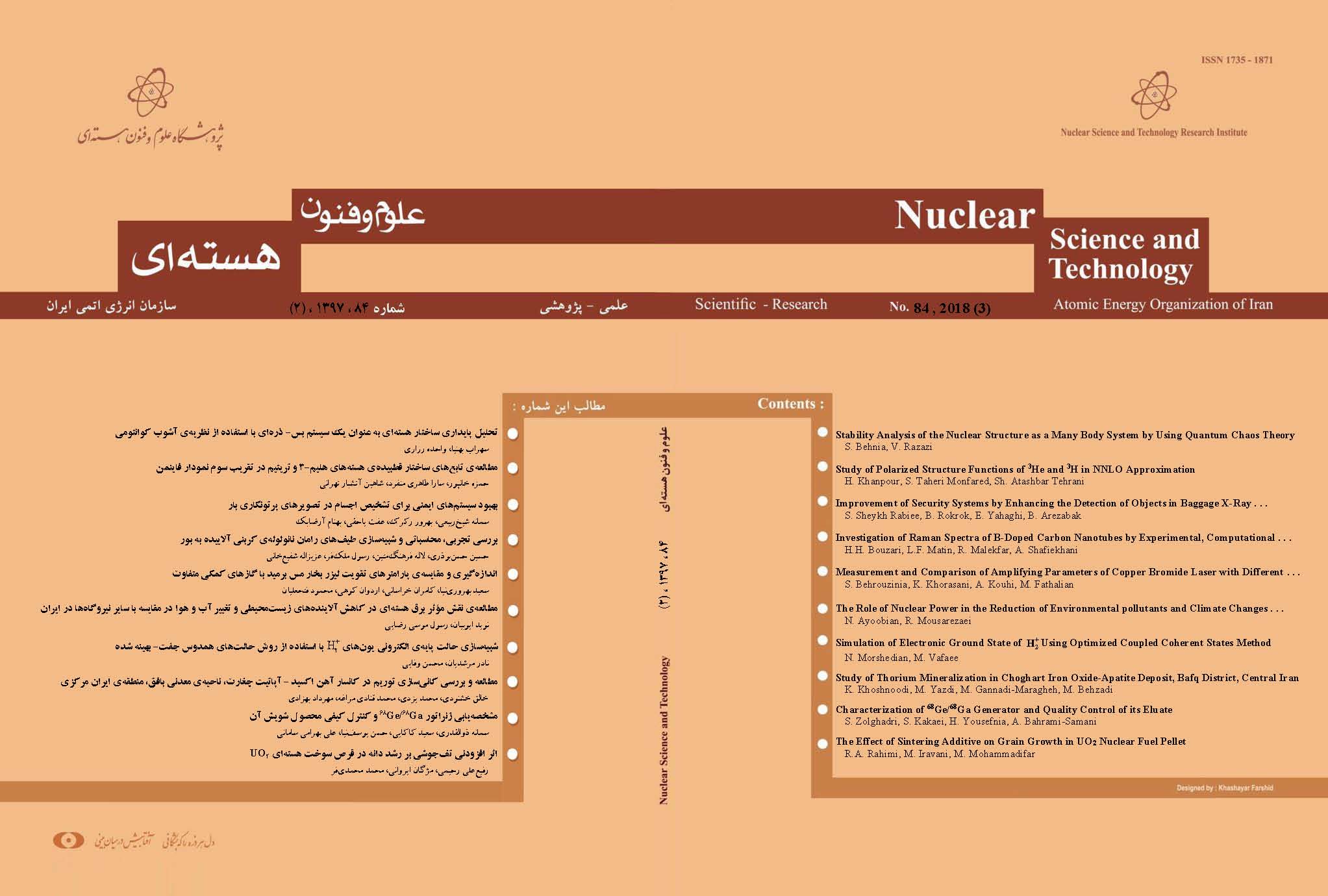نوع مقاله : مقاله پژوهشی
نویسندگان
1 1. دانشکدهی علوم پایه، دانشگاه آزاد اسلامی، واحد تهران شمال، صندوق پستی: 1651153311، تهران ـ ایران
2 2. دانشکده علوم پایه، دانشگاه تربیت مدرس، صندوق پستی: 175-14115، تهران ـ ایران
3 3. گروه فیزیک، دانشکدهی علوم، دانشگاه الزهراء، صندوق پستی: 1993893973، تهران ـ ایران
چکیده
با توجه به کاربردهای فراوان و مختلف نانولولههای کربنی آلاییده به بور، ارتعاشات مولکولی مرتبط با عنصر بور در نانو لولهی کربنی آلاییده به بور به سه روش تجربی، محاسباتی و شبیهسازی شناسایی شد. در بررسی تجربی، طیف رامان نانولولهی کربنی خالص و آلاییده به بور ثبت و مدهای حساس به رامان به ارتعاشات خاص ذیربط نسبت داده شد. در روش محاسباتی، بسامدهای ارتعاشی C-C و C-B(زنجیره کربنی خالص و آلاییده به بور) با مدل نوسانگر هماهنگ ساده، شبیهسازی و جابهجایی بسامد ارتعاشی به بسامدهای کوچکتر مشاهده شد. در نهایت با روش
شبیهسازی، بسامدهای ارتعاشی مولکولهای کربن- کربن و کربن- بور با استفاده از نرمافزار گاوسی مورد مطالعه قرار گرفت. بسامد مد ارتعاشی D وقتی بور کمتر از 3 درصد باشد به مقدار به بسامدهای کوچکتر جابهجا میشود (1336 cm-1 ® 1328 cm-1). آلاییدگی نانولولهی کربنی با درصدهای بین 4 تا 10 درصد بور، بسامد مدهای ارتعاشی را به مقدار به عددهای موج بالاتر جابهجا میکند (1328 cm-1® 1346 cm-1). رابطهی (نسبت ترکیبات کربنی بیشکل و مواد غیرکربنی در ساختار گرافیتی نمونه) با میزان آلاییدگی نانولولهی کربنی با بور افزایش مییابد(5/1®75/0). نتایج تغییرات شدت و بسامدهای مدهای ارتعاشی D و G با دقت قابل قبولی با روشهای تجربی، محاسباتی و شبیهسازی مورد تأیید قرار گرفت.
کلیدواژهها
عنوان مقاله [English]
Investigation of Raman Spectra of B-Doped Carbon Nanotubes by Experimental, Computational and Simulation Methods
نویسندگان [English]
- H H. Bouzari 1
- L F. Matin 2
- R Malekfar 2
- A Shafiekhani 3
چکیده [English]
In this paper due to the abundant and also different applications of carbon nanotubes doped with boron, molecular vibrations related to boron element were identified and investigated in B-doped carbon nanotubes by experimental, computational and simulation methods. In the experimental approach, Raman spectra of MWCNTs and B- doped MWCNTs were recorded and the Raman active modes assigned to the relevant specific vibrations. In the computational approach, the vibrational frequencies of C-C and C-B (pure carbon chains and doped with boron) oscillators were simulated using simple harmonic oscillator model and shift of vibrational frequencies toward lower wavenumbers was observed. Finally, by software simulation approach, vibrational frequencies of carbon-carbon and carbon-boron were investigated using the Gaussian software. The D- band intensity increased as the boron concentration reached to 3% while the center of the peak downshifted by 8 cm-1 (1336 cm-1 ® 1328 cm-1). Doping of carbon nanotubes with the boron concentration in the range of 4 to 10% upshifted the D- band central position by 18 cm-1 (1328 cm-1® 1346 cm-1). The ID-IG ratio (the intensity of the disorder D mode divided by the intensity of the graphite G mode) was increased by B-doping of carbon nanotubes (0.75®1.5). In conclusion, the results of the present article reveals that the intensity and frequency variations of D and G modes in the pure and the B doped MWCNT structures were approved with acceptable accuracy by the experimental, computational and simulation methods.
کلیدواژهها [English]
- Raman Spectroscopy
- Carbon Nanotubes
- Boron
- Doping

